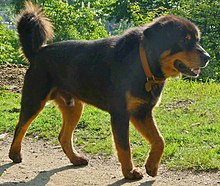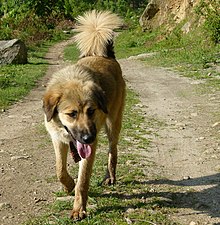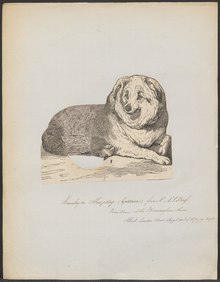Dog breed
| Himalayan Sheepdog | |||||||||||||||||||||
|---|---|---|---|---|---|---|---|---|---|---|---|---|---|---|---|---|---|---|---|---|---|
 A Himalayan sheepdog A Himalayan sheepdog | |||||||||||||||||||||
| Other names | Bhote kukur, Bhotia, Bangara, Gaddi Kutta, Himalayan Mastiff | ||||||||||||||||||||
| Origin | Nepal, India | ||||||||||||||||||||
| Breed status | Not recognised as a breed by any major kennel club. | ||||||||||||||||||||
| |||||||||||||||||||||
| Dog (domestic dog) | |||||||||||||||||||||
The Himalayan Sheepdog, known locally by various names including the Bhote, Bangara or Gaddi Kutta, and sometimes called the Himalayan Mastiff, is a breed of livestock guardian dog from the Himalayas. The Himalayan Sheepdog is found in the Himalayan foothills from eastern Nepal to Kashmir. The breed is primarily used as a livestock guardian dog, protecting flocks of yak and sheep from various predators, and as a property guardian dog; unusually for a livestock guardian, the breed is also used to assist with herding. The Himalayan Sheepdog is also used to assist in hunting.
Description

The Himalayan Sheepdog is very closely related to the slightly larger Tibetan Mastiff. The breed's double coat is typically harsh and thick and they are usually black and tan or solid black with some white markings on their toes, chest and neck. They have small drooped ears and a heavily plumed tail that is curled over their back. There are slightly distinct sub-varieties of the breed found in the Kumaon hills and Chamba; the former, which is known as the Cypro Kukur or Kumaon Mastiff, is brindle, rich golden brown or black in colour, the latter is smaller than most of the breed and resemble a larger, longer-haired black Labrador Retriever.


In 2005 the Himalayan Sheepdog was one of four Indian dog breeds featured on a set of postage stamps released by the Indian Ministry of Communications and Information Technology to celebrate the country's canine heritage.
See also
References
- Y. B.Rajeshwari (9 June 2009). Handbook on Care and Management of Laboratory and Pet Animals. New India Publishing. p. 13. ISBN 9788189422981.
{{cite book}}: CS1 maint: date and year (link) - "TrueTM".
- Fogle, Bruce (2009). The encyclopedia of the dog. New York: DK Publishing. p. 384. ISBN 978-0-7566-6004-8.
- ^ Hancock, David (2014). Dogs of the shepherds: a review of the pastoral breeds. Ramsbury, Wiltshire: The Crowood Press Ltd. pp. 14 & 32. ISBN 978-1-84797-808-0.
- ^ Morris, Desmond (2001). Dogs: the ultimate dictionary of over 1,000 dog breeds. North Pomfret, VT: Trafalgar Square Publishing. p. 404. ISBN 1-57076-219-8.
- ^ Soman, W.V. (1962). The Indian dog. Mumbai: Popular Prakashan. p. 73.
- Upadhye, Aishwarya (1 February 2019). "The comeback of Indian native dog breeds". The Hindu. Chennai. Retrieved 28 July 2020.
| Dogs originating in India and Sri Lanka | ||
|---|---|---|
| India | ||
| Sri Lanka | ||